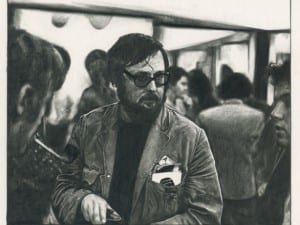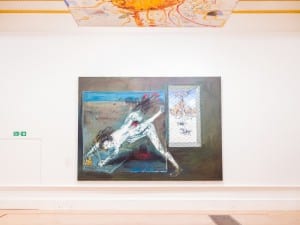Review by Paul Hardman
There is a moment in the film that accompanies the Thomas Struth: Photographs 1978-2010 exhibition, when the artist seems momentarily irritated with the interviewer. The subject of the influence of his former tutors, Bernd and Hilla Becher, has come up, and it is apparent that the comparison of their work to his is something that Struth has become a little tired of.
It is impossible though, not to address the influence of the Bechers, when considering Struth, or any other of the alumni of the Düsseldorf School of Photography (Kunstakademie Düsseldorf) who were taught by the Bechers in the 1970s. The rigorous consistency of the Bechers’ work, along with their teaching of the New Objectivity (Neue Sachlichkeit) must have made a deep impression on all of their students. In the film, Struth recalls the intimacy of the teaching at that time, when just a few students formed the group and would be taught intensely, socialising with their tutors outside of the academy as well as in class.
Bernd and Hilla Becher, of course, had an incredibly consistent body of work that is completely peerless, they stuck to their subject of documenting industrial buildings from when they first collaborated in 1959, for over 40 years. These images of cooling towers, gas towers, oil refineries and so on, record entire typologies of structures, in an approach that is exhaustive. Their compositions were always formally straight forward, and completely dispassionate, nothing is emphasised or exaggerated, and each building was recorded in exactly the same way.
The Bechers’ rigorous approach clearly has had an influence on Struth, but unlike that other great Düsseldorf alumni Andreas Gursky, whose compositions simplify subject matter into flat rectangular strips on a vast scale, Struth’s photography is willing to include complexity, and in many of the images in this exhibition he fills the frame with intersecting lines and forms. This is shown whether in the oblique aerial views of Korea, intensely detailed pictures that include whole landscapes of forests, streets, and tower blocks – photographs of the insides of labs and space technology, in which wires and gadgets provide a baffling tangle – or the huge images of forests and jungles, the Heaven series, in which almost the entire floor to ceiling frame is filled with interwoven foliage.
Struth continues the tradition of objective and dispassionate work, championed by the Bechers, and he maintains a clear fascination with technological and urban development. In many of his photographs the buildings are presented in such a way that people can be seen to scale with their surroundings, dwarfed by the vastness of the built environment. Tower blocks are revealed to be something slightly monstrous as they tower above or oppressively crowd around the more human scale buildings. In the accompanying film Struth himself compares an oil rig, in one of this exhibitions most striking images, to a chained bear. His photograph shows a rig in a dock, with chains coming from the foreground of the image right up to the higher parts of the structure, so that it appears that it is indeed some kind of beast to be restrained and feared. In this image then, it is possible to detect a clear break with the style of the New Objectivity, although subtly, Struth does allow himself to make a comment and take a point of view, rather than simply taking the role of the observer, the documenter. He allows his subjective ideas to make their mark on the image.
Struth’s work is also characterised by a diversity of subjects, he does work in sequences or ‘typologies’, but even within these sets he allows himself substantial movement. A case in point is the photographs of visitors to galleries and museums. In some of these he has photographed the visitors as they are, bustling around the paintings of the Prado, in others he has replaced the real visitors with extras and the images take on a more epic quality, so that huge panoramas are created. The opening exhibition of the show is from these series, a group of gallery visitors are viewed from the perspective of the painting, or slightly below it, so that we find ourselves looking up at the rapt faces of the visitors. Of course, since there is some ambiguity over whether these people are genuine, or are in fact posed by Struth, this photograph sets up a kind of reflexive dilemma creating a self examination as one explores this exhibition, ‘how do we act in the gallery space, how genuine are we ourselves in this role?’.
The exhibition moves from the gigantic scale of the tower blocks and museums to a much more comfortable scale in Struth’s series of family portraits. This change of scale and pace provide a different dimension to the exhibition that affects how the other images are seen. These again are global in reach, from Japan to Germany to the U.S., but instead of marvelling at the complexities of urban development, the subject becomes the subtleties of family relationships, the balance of power in these relationships, family resemblances, vernacular interiors and so on. But on another level the subject is similarly to the urban panoramas, how an individual finds their place in a wider group, in a wider context, and again, this becomes a reflexive situation. The question arises as to what these family portraits of (mostly) anonymous sitters reveal, and what they hide. A viewer must find themselves considering their own families and in turn the vastness of humanity in general – something that may not have been the case if these photographs were not preceded and followed by the other more macro scenes of modern cities.
It is in setting up these tensions that this exhibition raises itself to another level, above the technical expertise and spectacular imagery that is on display. In both the arrangement and placing of the pictures in the gallery, and in the complexities inherent in the ideas of each series, the exhibition builds and builds, and Struth’s work proves itself as a subtle but masterly oeuvre.
Thomas Struth: Photographs 1978-2010 runs until 16 September.
whitechapelgallery.org
Aesthetica Magazine
We hope you enjoying reading the Aesthetica Blog, if you want to explore more of the best in contemporary arts and culture you should read us in print too. In the spirit of celebration, Issue 41 includes a piece on Guggenheimn Bilbao where the Luminous Interval features internationally acclaimed artists such as Louise Bourgeois, Kiki Smith and Damien Hirst, ArtAngel’s new commission at MIF, Bruce Nauman’s retrospective at The Kunsthalle Mannheim and Cory Arcangel’s Pro Tools at the Whitney in NYC. You can buy it today by calling +44(0)1904 479 168. Even better, subscribe to Aesthetica and save 20%. Go on, enjoy!
Image:
Semi Submersible Rig (2007)
Courtesy the artist




